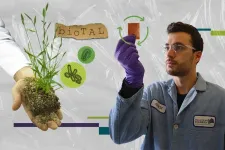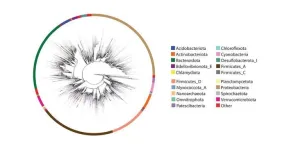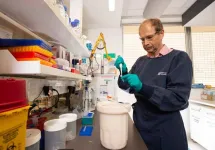(Press-News.org) University of Missouri researchers are striving to find solutions to the leading cause of maternal mortality in the world — preeclampsia. For Laura Schulz, an associate professor of obstetrics, gynecology and women’s health in the University of Missouri School of Medicine, understanding the root causes of preeclampsia and other complicated, life-threatening maternal conditions is pivotal in advancing women’s health care.
Supported by a renewed $3 million grant from the National Institute of Child Health and Human Development (NICHD), Schulz and her team will use trophoblast cells, which are cells that develop in the placenta and provide nutrients to the growing embryo, to understand how placental defects that cause preeclampsia function. The goal is to learn the disease’s tell-tale signs, which would enable doctors to diagnose, treat, and, ultimately, prevent preeclampsia.
Joining Schulz on the project is co-principal investigator R. Michael Roberts at MU and co-investigators Toshihiko Ezashi at the Colorado Center for Reproductive Medicine and Danny Schust at Duke University.
“Preeclampsia is characterized by high blood pressure and protein in the urine, and it can progress to multisystem organ failure,” Schulz said. “It can also cause stroke, postpartum hemorrhage or, commonly, premature birth, which has all kinds of consequences for the baby.”
While scientists can easily observe the placenta at birth, one of the challenges in studying this disease is that the remodeling of spiral arteries in the uterus — those that supply blood to the placenta — occurs in the first trimester, making it particularly difficult to study as it’s happening. Spiral artery remodeling appears to go wrong in preeclampsia. To study the early stages of pregnancy, without impacting the pregnancy, the researchers are examining umbilical cord cells after the birth occurs.
“What we do is take umbilical cord cells from either a normal pregnancy, or one complicated by preeclampsia after the baby’s been born,” Schulz said. “Then we re-program these cells to turn them into trophoblast cells. That way we can look at cells that resemble placental cells and try to figure out what might be going on in early pregnancy that can lead to the development of all these problems.”
In a prior study, the research team developed umbilical cord-based cell models to test whether they could recapitulate any of the features that are often seen in preeclampsia patients. This new funding will allow for an expansion of this work to make organoids — three-dimensional tissue cultures derived from trophoblast cells — so the researchers can understand the architecture of the tissues and to make specific kinds of trophoblast, the cells of the placenta, to learn more about how this organ works.
“I started off as a comparative reproductive biologist,” Schulz said. “I was mostly interested in how pregnancy happens in different kinds of animals and species-specific factors. And then I got more interested in human pregnancy when I joined an OB-GYN department and learned the implications for women's health and their babies. Now, I’m broadly interested in how we make healthier pregnancies and a more favorable maternal environment during pregnancy while optimizing fetal bone and muscle growth.”
END
New $3 million grant supports research on leading cause of maternal mortality worldwide
MU researcher Laura Schulz has dedicated her career to studying the intricacies of maternal health related to the placenta, research that advances knowledge on common diseases like preeclampsia
2023-07-27
ELSE PRESS RELEASES FROM THIS DATE:
Making renewable, infinitely recyclable plastics using bacteria
2023-07-27
Plastic waste is a problem. Most plastics can’t be recycled, and many use finite, polluting petrochemicals as the basic ingredients. But that’s changing. In a study published today in Nature Sustainability, researchers successfully engineered microbes to make biological alternatives for the starting ingredients in an infinitely recyclable plastic known as poly(diketoenamine), or PDK.
The finding comes from collaboration among experts at three facilities at the Department of Energy’s Lawrence Berkeley National Laboratory (Berkeley Lab): the Molecular Foundry, the Joint BioEnergy Institute ...
Short bursts of daily activity linked to reduced cancer risk
2023-07-27
Promising new research suggests a total of just 4.5 minutes of vigorous activity that makes you huff and puff during daily tasks could reduce the risk of some cancers by up to 32 percent.
Published in JAMA Oncology and led by the University of Sydney, Australia, the study used data from wearable devices to track the daily activity of over 22,000 ‘non-exercisers’. Researchers then followed the group’s clinical health records for close to seven years to monitor for cancer.
As few as four to five minutes of vigorous intermittent lifestyle physical activity or ‘VILPA’ was associated with a substantially lower cancer risk compared to those who undertook no ...
Johns Hopkins Applied Physics Laboratory restores cold sensation in amputees’ phantom limbs
2023-07-27
Johns Hopkins Applied Physics Laboratory (APL) researchers have developed one of the world’s smallest, most intense and fastest refrigeration devices, the wearable thin-film thermoelectric cooler (TFTEC), and teamed with neuroscientists to help amputees perceive a sense of temperature with their phantom limbs. This advancement, one of the first of its kind, enables a useful new capability for a variety of applications, including improved prostheses, haptics for new modalities in augmented reality (AR) and thermally-modulated therapeutics for applications such as pain management. The technology also has a variety ...
New resource harmonizes 16S and shotgun sequencing data for microbiome research
2023-07-27
Two leading sequencing techniques are no longer at odds, thanks to an international effort led by scientists at University of California San Diego. In a study published July 27, 2023 in Nature Biotechnology, the researchers debuted a new reference database called Greengenes2, which makes it possible to compare and combine microbiome data derived from either 16S ribosomal RNA gene amplicon (16S) or shotgun metagenomics sequencing techniques.
“This is a significant moment in microbiome research, as we’ve effectively rescued over a decade’s worth of 16S data that might have otherwise become obsolete in the modern world ...
Preventing weight gain: Yo-yo no-go zones for Australians
2023-07-27
There’s no doubt that Aussies love a good celebration. We’re all in when it comes to the weekend, and most of us can’t go past a Christmas celebration without a little bit of overindulging. But all this comes at a cost, and it’s taking a massive toll on our waistline.
Now, a world-first study from the University of South Australia exposes the real weight gains of everyday Australians, in a move to tackle overweight and obesity.
Funded by the NHMRC, and published in JAMA Open Network today, the study explored how weight changes across a 12-month period, finding that weight fluctuated throughout the year.
Specifically, ...
Closing cancer cell’s escape route
2023-07-27
Chemotherapy and radiotherapy aim to destroy cancer cells by inducing DNA double-strand breaks – damage that, once inflicted, usually causes the cells to die. But damage to a cell’s genetic material also activates a signaling pathway called IKK/NF-κB that helps prevent cell death, thus limiting the success of these treatments in patients.
NF-κB is a family of gene regulators that controls a wide variety of cellular processes – from immune responses to embryonic development – and is activated by the enzyme complex ...
Fiber-infused ink enables 3D-printed heart muscle to beat
2023-07-27
Over the last decade, advances in 3D printing have unlocked new possibilities for bioengineers to build heart tissues and structures. Their goals include creating better in vitro platforms for discovering new therapeutics for heart disease, the leading cause of death in the United States, responsible for about one in every five deaths nationally, and using 3D-printed cardiac tissues to evaluate which treatments might work best in individual patients. A more distant aim is to fabricate implantable tissues that can heal or replace faulty or diseased structures inside a patient’s heart.
In a paper published in Nature Materials, researchers ...
New technology promises rapid and reliable development of new diagnostic tests
2023-07-27
QUT researchers have developed a new approach for designing molecular ON-OFF switches based on proteins which can be used in a multitude of biotechnological, biomedical and bioengineering applications.
The research team demonstrated that this novel approach allows them to design and build faster and more accurate diagnostic tests for detecting diseases, monitoring water quality and detecting environmental pollutants.
Professor Kirill Alexandrov, of the QUT School of Biology and Environmental ...
Jinghui Zhang, Ph.D., elected Fellow of the International Society for Computational Biology
2023-07-27
(Memphis, Tenn. – July 27, 2023) St. Jude Children’s Research Hospital proudly announces that Jinghui Zhang, Ph.D., Member of the Department of Computational Biology, has been elected as a Fellow of the International Society for Computational Biology.
Zhang is one of 15 scientists given this distinction in 2023. She’s being honored for the development and application of innovative computational methods, discovering novel targets and accelerating research and genomic data sharing to advance the diagnosis, treatment and surveillance of pediatric cancers and survivors.
“I ...
Motivation and pleasure deficits play important role in social functioning across psychiatric disorders
2023-07-27
Dr. Raymond Chan's team from the Institute of Psychology of the Chinese Academy of Sciences and his collaborators have recently shown that amotivation and anhedonia, rather than expressive dysfunction, play a crucial role in determining the social functioning of schizophrenia patients.
The study was published in Nature Mental Health.
Negative symptoms refer to the loss of normal functioning, including anhedonia, avolition, alogia, asociality, and affective blunting, and have been shown to be the most important predictors ...
LAST 30 PRESS RELEASES:
Making lighter work of calculating fluid and heat flow
Normalizing blood sugar can halve heart attack risk
Lowering blood sugar cuts heart attack risk in people with prediabetes
Study links genetic variants to risk of blinding eye disease in premature infants
Non-opioid ‘pain sponge’ therapy halts cartilage degeneration and relieves chronic pain
AI can pick up cultural values by mimicking how kids learn
China’s ecological redlines offer fast track to 30 x 30 global conservation goal
Invisible indoor threats: emerging household contaminants and their growing risks to human health
Adding antibody treatment to chemo boosts outcomes for children with rare cancer
Germline pathogenic variants among women without a history of breast cancer
Tanning beds triple melanoma risk, potentially causing broad DNA damage
Unique bond identified as key to viral infection speed
Indoor tanning makes youthful skin much older on a genetic level
Mouse model sheds new light on the causes and potential solutions to human GI problems linked to muscular dystrophy
The Journal of Nuclear Medicine ahead-of-print tip sheet: December 12, 2025
Smarter tools for peering into the microscopic world
Applications open for funding to conduct research in the Kinsey Institute archives
Global measure underestimates the severity of food insecurity
Child survivors of critical illness are missing out on timely follow up care
Risk-based vs annual breast cancer screening / the WISDOM randomized clinical trial
University of Toronto launches Electric Vehicle Innovation Ontario to accelerate advanced EV technologies and build Canada’s innovation advantage
Early relapse predicts poor outcomes in aggressive blood cancer
American College of Lifestyle Medicine applauds two CMS models aligned with lifestyle medicine practice and reimbursement
Clinical trial finds cannabis use not a barrier to quitting nicotine vaping
Supplemental nutrition assistance program policies and food insecurity
Switching immune cells to “night mode” could limit damage after a heart attack, study suggests
URI-based Global RIghts Project report spotlights continued troubling trends in worldwide inhumane treatment
Neutrophils are less aggressive at night, explaining why nighttime heart attacks cause less damage than daytime events
Menopausal hormone therapy may not pose breast cancer risk for women with BRCA mutations
Mobile health tool may improve quality of life for adolescent and young adult breast cancer survivors
[Press-News.org] New $3 million grant supports research on leading cause of maternal mortality worldwideMU researcher Laura Schulz has dedicated her career to studying the intricacies of maternal health related to the placenta, research that advances knowledge on common diseases like preeclampsia





